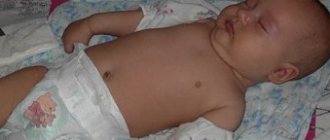From the first weeks of life, babies grow quite quickly. At four months of age, the baby begins to distinguish between images of people. He especially singles out his mother. Most likely, parents have already noticed that sleep time has decreased and wakefulness has increased. This means that the baby's daily routine has changed at 4 months.
The baby can be active for 2 hours. During his activity, the child explores the sounds and objects around him. He is not interested in lying around doing nothing.
Now the baby distinguishes day from night and wakes up to feed less and less often.
Emotional and physical development
When the baby turns four months old, parents notice that their little one has grown, and his hair and eyes have begun to change color. The hair with which the baby was born begins to fall out, and new ones grow in its place. Over time, the eyes become the same color as mom or dad.
Since the infant (4 months) previously moved quite little, now he is rapidly strengthening his muscles. Due to the fact that the muscles became stronger, the baby learned to hold his head independently by this age. The baby constantly turns it around, trying to get a better look at the things around him. The child likes to watch his parents' reaction to his actions.
In the 4th month, the baby will gain from 600 to 750 grams of weight. The child's height will change by 2.5 centimeters.
What has a baby learned by 4 months?
At this age, the baby is quite active and curious. Previously, it was enough for him to look at everything, but now there was a desire to touch every thing.
If you place the baby on his tummy, he will rise up on his forearms. Some children may roll over onto their back by pushing off the bed with their arm.
Having placed the child on the table, parents will notice how the baby begins to jump. Since a child at this age is usually very active, he needs to be held firmly by the armpits.
You should be careful with small objects, as the baby tries to put everything that gets into his hands into his mouth. When a child turns 4 months old, Komarovsky advises parents to buy rubber toys. This is necessary so that the little one can develop his gums.
The baby will be very surprised, and sometimes even frightened, if the appearance of his parents changes. For example, seeing a father in a jacket or a mother in a hat. This is due to the fact that he remembered their original appearance.
Another new ability of the baby is speaking in syllables. He says “agu”, “am” and the like.

Baby mode 4-5 months

The baby continues to grow and develop; at 5 months he may already have his first tooth. It’s good if teething in children occurs without “deplorable” consequences, otherwise the whims of toddlers risk seriously disturbing the peace of the family. The daily routine undergoes some changes over the course of 4-5 months: daytime sleep time decreases and night rest increases, the baby begins to spend more active time between feeding and sleep.
4-5 month baby routine - Food and sleep
A five-month-old baby sleeps three times during the day for 1.5-2 hours after a hearty breakfast, lunch and afternoon snack. Night sleep becomes longer, it can be up to 11 hours, but this does not exclude a night feeding or even several. The baby may wake up at night looking for its mother and demanding the breast. This behavior is completely normal for a baby; perhaps he is just looking for reassurance from a night's sleep or sympathy for a cutting tooth. Breast milk is a universal elixir for children. Night breastfeeding will not change the baby’s general routine too much, because he eats little and wakes up hungry in the morning. At this age, it is already possible to determine whether a child is a “lark” or a “night owl,” although most kids get up early in the morning because they go to bed early. This can cause some inconvenience for the mother: she wants to sleep longer in the morning, because in the evening, after putting the baby to bed, she managed to redo all the things. This is where loved ones can come to the rescue.
Gymnastics and play
A child's waking hours can be occupied by more than just eating. Play and physical exercise play a major role during this period. Regular gymnastics accelerates the baby's development and improves his motor skills. Children begin to crawl faster and then walk. You can perform the exercises several times a day for 5-7 minutes, so that the baby does not get tired, but is happy. The game becomes one of the points of the daily routine, since it is the starting point for the child; through the game the child begins to explore the world. Often the game begins with the baby pulling an interesting object into his mouth, this is especially true during the period when children are teething. Looking at the rattle and making movements with it, the child observes what is happening, draws conclusions, and learns. Play time in the schedule immediately follows feeding; a well-fed, well-rested baby begins to play and communicate with adults with pleasure.
Baby mode 4-5 months - Walking
Walking at the age of 4-5 months also takes on a new meaning. If earlier the baby fell asleep as soon as he was taken out into the fresh air, now the child diligently gawks at the space around him. Being outside is still considered rest for the mother, because the child is calm and focused on contemplation. However, for its development, only observation is not enough, so the mother must, while walking, comment on what is revealed to the child’s gaze. Such communication will help expand his horizons and intellectual abilities. The duration of the walk depends on weather conditions; in summer you can walk longer; in winter you can carry the baby if the temperature on the thermometer does not drop below 10 degrees.
When making a child the center of your universe, you should not forget that he needs not only warmth, a comfortable bed and food, but also communication with his dearest person, through whom he gets to know the world around him.
Anastasia Ilchenko
Note to mom: When walking, your child should not be in a stroller all the time. Of course, it’s too early for him to play on children’s playgrounds, but it will be interesting for him to look at the world around him, sitting in his mother’s arms.
Baby's sleep
The baby's routine at 4 months has changed, so his sleep time has also decreased. A toddler can sleep no more than 15 hours per day. At the same time, during the day the baby sleeps three times for 2 hours. At the age of four months it is already possible to determine whether he is a “lark” or a “night owl”.
Some children wake up very early, and this continues into older age. Other babies fall asleep together with their parents, and sometimes later. Such children wake up no earlier than 9 o'clock in the morning.
Larks give mother more trouble because they fall asleep before she does. After the little one has fallen asleep, mom gets to work on her homework. Having finished all her work, she goes to bed. Unfortunately, she won't be able to sleep for long. This is due to the fact that she is a “lark” and gets up very early.

Feeding regimen for a 4 month old baby
Five meals a day at four months is the norm for a child. Today, there are three types of nutrition for four-month-old children: breast, artificial, mixed. It all depends on whether a woman can breastfeed, as well as on the amount of milk her body produces.
It’s interesting that just a month ago the baby ate six times, but now five is enough for him. This is due, first of all, to the fact that the child now consumes more milk or formula per feeding than before. At 4 months, the baby needs about a liter of mother's milk per day. That is, one dose is 150-200 ml. The same portions apply to artificial feeding.
It is too early to introduce the first complementary foods while breastfeeding, since pediatricians advise starting complementary foods no earlier than 6 months. Only in rare cases, if the baby was born premature or is gaining below normal weight, the doctor may advise combining complementary feeding with breast milk.
The feeding regimen of a 4-month-old baby on artificial feeding can gradually switch to complementary feeding. How to properly introduce the first complementary foods - read in the additional article on complementary feeding.
Baby food
As before, a baby’s diet at 4 months includes formula or mother’s milk. If a nursing mother's milk supply has decreased, she needs to do everything to increase lactation. Don't forget about rest, plenty of fluids and good nutrition.
It is best to feed the baby every 3-4 hours, no more than six times a day. At night, the interval between feedings is 7 hours. The first complementary foods begin at 3.5-4 months. Fruit juice or puree serves as additional nutrition. When complementary foods are introduced, the interval between feedings will increase to four hours. At night it is 8 hours. The first feeding begins as soon as the baby wakes up.
To make it easier to properly feed a child at 4 months, pediatricians have compiled an approximate table.
Baby feeding time table
| Feeding time | Menu | Amount of single dose in ml. |
| 6 hours 00 minutes | mother's milk (formula) | 165-170 |
| 9 hours 30 minutes | mother's milk (formula) | 165-170 |
| fruit juice | 20,0 | |
| 13:00 | mother's milk (formula) | 165-170 |
| fruit puree (pear or apple) | 25,0 | |
| 16 hours 30 minutes | mother's milk (formula) | 165-70 |
| fruit juice | 20,0 | |
| 20 h. 00 min. | mother's milk (formula) | 165-170 |
| 23 h. 00 min. | mother's milk (formula) | 165-170 |
Of course, feeding times may vary slightly from what is indicated in the table. It is best to consult with your local pediatrician who is monitoring your child. Feeding will depend on the overall development of the baby.
Baby's daily routine at 4 months
The daily routine of a 4-month-old baby is significantly different from the routine of a three-month-old baby. This is due to an increase in the duration of night sleep - most children, between the fourth and fifth month of life, switch to one night feeding, and the duration of night rest reaches 8-9 hours. Features of psycho-emotional and physiological development also require correction of the regime, since the child begins to actively explore the surrounding space, and periods of continuous wakefulness can reach 3-4 hours.
Approximate daily routine and nutrition of a child at four months
Below is an approximate daily routine for a four-month-old baby, which each mother can adjust taking into account the characteristics of the child, as well as the needs of the rest of the family.
You don't have to strive for the routine presented above. According to statistics, less than 10% of infants live according to the regime accepted as the standard norm. All children are individual, each with their own character and pace of physical and physiological development, which have a direct impact on their daily routine. Parents can adjust the given routine, but if the child becomes restless, refuses to eat and is often capricious, you should consult a doctor. The pediatrician will help create a regimen that is most suitable for a particular child and meets his needs.
Daily routine of a three-month-old breastfed baby
The diet of children at the beginning of the fifth month of life requires certain correction. The baby's digestive system already produces a sufficient amount of enzymes necessary for the digestion of food, so the volume of milk that the baby can absorb in one feeding should increase from 150 ml to 180-200 ml. In this regard, six meals a day must be replaced with five meals a day, increasing the interval between feedings to 4 hours.
If the mother is breastfeeding and adheres to “feeding on demand”, you can leave the child’s usual regimen, but the minimum interval between feedings should be 3 hours. This is necessary for the normal functioning of the digestive organs, comfortable digestion and the prevention of heaviness in the stomach. In addition, frequent and heavy breastfeeding can cause regurgitation even at four months of age, so it is better not to overload the baby's stomach.
Important! Some mothers give the breast to their baby as soon as he starts crying. Parents should know that only in 13-20% of cases, crying of a healthy baby between feedings means a feeling of hunger. There can be many reasons for restless behavior: fear, cold (or, conversely, overheating), uncomfortable clothing, fatigue. Before offering the breast, you should try to distract the baby and eliminate possible negative factors.
The daily routine of a bottle-fed or mixed-fed baby
Children receiving breast milk substitutes as their main diet, starting from the fifth month of life, should receive meals 5 times a day. The interval between feedings during this period increases from 3 to 4 hours. This is necessary for the prevention of digestive disorders, intestinal colic, spasms and normal absorption of food. The protein contained in infant formula is absorbed by the baby’s digestive system longer and harder than the proteins that form the basis of mother’s milk.
The serving size by 4 months should be 200 ml. If the baby continues to be fed every 3 hours, the formula will not have time to be fully absorbed, since enzymes that break down protein and milk sugar will not be produced in sufficient quantities. The consequences of improper feeding can be:
- intestinal cramps and stomach pain;
- excessive regurgitation of undigested milk;
- belching;
- increased flatulence.
For some children at this age, the pediatrician may recommend introducing complementary foods. Typically, additional nutrition is required for children with low body weight, retarded physical development, and suffering from various forms of anemia. It is recommended to start complementary feeding with dairy-free cereals that do not contain gluten, a complex protein that is part of the gluten of most cereals. Buckwheat or rice porridge would be an ideal choice for a first introduction to grains, but rice dishes should not be given to children prone to constipation until six months of age.
Sugar-free apple juice, zucchini puree and apple and pear puree can also be used as first complementary foods. Brightly colored fruits, as well as vegetables with a high purine content, are introduced no earlier than five months of age. Peas can be given to a child only at 7-8 months.
Menu for a 4-month-old bottle-fed baby
An approximate menu for children receiving complementary foods is given in the table below. The volume of meals is indicated for the end of the fifth month of life.
Schedule
As soon as your baby is 4 months old, you can start organizing his daily routine. For example, after sleep, a toddler should eat, then play, and only then go to bed again. To have a good appetite, it is necessary to observe intervals between sleep and feeding.
It is best to create a schedule for you and your child to live by in the coming month.
Approximate schedule:
- As soon as the baby wakes up, he needs to be fed.
- A well-fed child is ready to play a little. The waking time is 2 hours.
- Tired of playing, the baby should sleep. The first nap lasts approximately 2 hours.
- When the baby wakes up, he will want to eat, so you need to feed him a second time.
- After eating, the little one will stay awake for at least 2 hours.
- At lunchtime, the child should be put to bed again.
- After 2 hours he will wake up and want to eat again.
- After the meal, you need to play with the baby for about 2 hours.
- Now it’s time to put the baby to bed.
- Upon waking up, the child should eat for the fourth time.
- And again I was awake for an hour and a half.
- Let's start the last feeding.
- A well-fed baby is ready to go to bed. He will sleep until the morning.

This is not a guide, as every mother knows what her baby currently wants. Some mothers are interested in how long a child should sleep (4 months). How much a toddler sleeps will depend on his mood and state of health.
Walks
In order for a child to develop well, he must not only eat and sleep, but also walk in the fresh air. He will be very interested in looking at the trees, people passing by and moving cars. If the child liked something, it must be commented on. For example, a child is happy about a passing car, you need to tell him that it is a car. After breathing fresh air, the child will sleep more soundly, and his appetite will improve.
Unfortunately, a 4-month-old child’s routine may include a minimum number of walks if the outside temperature drops below -10 degrees. Cold air can harm your baby's health.

The child should get acquainted with the world around him from an early age, so that in the future it will be easier for him to integrate into everyday life.
Pedagogical complementary feeding
Breastfed babies get used to new food faster, because they are already indirectly familiar with the taste and aroma. Pedagogical complementary feeding is the most natural type of introduction to adult food and is most compatible with breastfeeding.
The principle of complementary feeding is that the child does not gorge himself on new food, but tastes it, thereby preparing the digestive system to accept dishes inherent in the usual diet of the region of residence and a particular family. The baby also develops the skill of eating together.
In practice this method is very simple. When the mother eats, she holds the child in her arms at the table, having previously given him a spoon. If the baby shows an active interest in what is happening and reaches for food with his hands or spoon, then he is given a small piece to try. And so on, little by little.
Read also:
Why may a newborn not poop for several days?
This gives impetus to the development of the baby’s own enzymatic system. New foods that are consumed together with the mother and the enzymatic support received from breast milk are more easily tolerated. If a child really likes a product, its volume can be increased to a teaspoon.
But you shouldn’t stop at just one thing; the purpose of complementary feeding is to introduce the baby to all the products in microdoses that are present on the family table.
With this method, you need to eat healthy food with your baby - exclude fried, smoked, etc.
Hardening
A very important part of children's upbringing is hardening. It must be systematic so that the baby is always healthy. You can harden your child regardless of the time of year. A very good way to harden yourself is to walk in the fresh air.
Air baths are also good. It is recommended to carry them out twice in one day for 10 minutes at a temperature of +22 degrees. Feeding a 4-month-old baby will go better after he gets some fresh air and his appetite is worked up.
It is very useful to wipe the child’s skin with a dry mitten made from terry cloth. This should be done until slight redness appears. Don't forget that your baby's skin is quite delicate.
After 1-1.5 weeks, you can wipe the baby with a wet mitten. The terry mitten is moistened with water and then wrung out a little. The water should not be hotter than +36 degrees. Every three days the temperature should be reduced by 1 degree. The duration of rubdowns is no more than 2 minutes.
How to organize a newborn's daily routine
Accustoming a child to a schedule is a very delicate process, largely dictated by the individual characteristics of the baby. To begin with, just watch him. You will notice that the baby already has his own routine. He performs all his actions at approximately the same time.
If you cannot determine the system in his routine, think about what could be preventing him from sleeping and eating at the same time? You may need help from a pediatrician.
What you need to do to quickly establish the regime:
- Develop the habit of falling asleep quickly in your newborn. To do this, you need to put him to sleep in the fresh air (on the street or by ventilating the room 10 minutes before bedtime), rock him to sleep for 3 - 4 minutes, and sing a lullaby.
- Avoid overtiredness (it is better not to play active games before bedtime).
- Walk in the fresh air (from 8 to 10 months you need to be outside not only during sleep, but also while awake).
- Organize feeding correctly (do not interrupt the baby’s appetite, do not overfeed, synchronize complementary feeding with adult meals: breakfast, lunch, afternoon snack, dinner).
- During the day, make sure that the lighting is bright, and at night, strive for silence and dim light so that the child gets used to the fact that night is for rest.
Breastfeeding helps maintain sleep patterns and strengthen the baby's nervous system. Therefore, it is better to preserve it for as long as possible.
- Saturate the baby’s life with active activities (visiting, getting to know the outside world, getting involved in everyday activities, games (including with water), classes, gymnastics and massage, swimming pool).
- Observe rituals (eating with other family members, a bedtime story, bathing and walking at the same time, a favorite toy for visiting).
- Follow the regime with the whole family (it will be easier for the child if everyone in the household eats and goes to bed at the same time, convenient for him).
- Stick to a schedule every day: make sure your child sleeps, eats, plays and walks at the same time. It is better to tell him in advance about what will happen during the day.
Typical mistakes to avoid:
- Keep your child awake. If the baby is not yet six months old, then he should sleep every 2 hours. Otherwise, the baby will become overtired and capricious.
- Go radically against his natural rhythm. If a mother tries to accustom a child to a routine who previously had no routine at all or one that was radically different from the new one, then most likely she will not succeed, and the baby will be stressed.
- Start accustoming yourself to a routine during travel, moving or other changes. In the first two weeks, when you introduce a routine, you need to make this task a priority, and adapt all other plans to the child’s new daily routine.
Games and gymnastics
While awake, the baby should not only play, but also study. It is for this reason that a child’s daily routine at 4 months should include gymnastics. This is necessary because the baby will soon begin to sit, crawl, and then walk. It is necessary to knead the child’s muscles and joints for 5 minutes 3 times a day. Your toddler should enjoy gymnastics. Never allow your child to become overtired.
During games, the baby tries to explore the world around him. First of all, he begins to study the toys with which he plays. First, the baby touches them with his hands, and then drags them into his mouth. A 4 month old child should play with rubber toys. They will help teething.
It is also very important that adults play with the baby, because he gains experience from them.
Buy in the online store, best prices, inexpensive delivery
The daily routine should be planned as conveniently as possible for you and your baby. As always, it’s good to start the morning by washing and toileting your eyes, nose and ears. Previously, mothers had to tinker with water and boric acid, herbal infusions and thoroughly boiled water to wash the child. At 4 months, you can do without such painstaking procedures, since the baby’s lacrimal glands have become quite developed and no longer need frequent hydration. But, if your child is diagnosed with conjunctivitis, then all of the above procedures must be repeated every morning.
The daily routine should be planned as conveniently as possible for you and your baby. As always, it’s good to start the morning by washing and toileting your eyes, nose and ears. Previously, mothers had to tinker with water and boric acid, herbal infusions and thoroughly boiled water to wash the child. At 4 months, you can do without such painstaking procedures, since the baby’s lacrimal glands have become quite developed and no longer need frequent hydration. But, if your child is diagnosed with conjunctivitis, then all of the above procedures must be repeated every morning. To wash the baby, it is convenient to use a cotton swab dipped in slightly warm boiled water. Pay special attention to the corners of your eyes, because after sleep, dried mucous secretions remain there. They should not get on the conjunctiva of the child’s eye, otherwise it can be scratched. It is not recommended to rub your eyes. When washing your face, follow the direction from the inner to the outer corner. Even such a minor procedure will be enough to make the baby feel comfortable.
At this age, children's nails grow much faster than before. Mothers need to be very careful and cut them every time so that the baby, waving his arms and playing, does not scratch himself. But it is worth remembering that cut nails too short can later cause an unpleasant and painful growth of skin on the nail plate.
To play with your baby, it is recommended to use large toys of bright, rich colors. Small removable parts in them are simply unacceptable, because the baby does not yet understand “what it is” and can easily swallow it and choke. Periodically they need to be washed with soap and boiled water or treated with an antiseptic. Toys, like clothes, must be selected according to age. Games encourage children to be creative and stimulate motor skills.
Walks become longer. In summer, you can walk with your baby in the fresh air for 2-3 hours at temperatures up to +30ºC, and in winter – about 2 hours. At -10ºC or more in winter, it is better to stay at home so that the child does not freeze and does not get sick.

It is recommended to do massage twice a day (morning and evening), when the baby is awake and full of energy. It is better to start procedures 20-30 minutes after the last feeding to prevent regurgitation of food. You can perform the massage yourself or call a specialist at home. It should be remembered that the exercises should not last long, otherwise the baby will get tired and will not allow you to calmly carry out the next session.
Towards the evening, engage in water procedures. On hot summer days, children can be bathed daily. The temperature of the water in the bath should reach 35-36ºC. Then the baby is doused with water cooler by 1-2ºC. The whole procedure should last 5-7 minutes, after which the baby should be wiped dry with a soft towel. After a warm bath, babies usually fall asleep peacefully.
4 month old baby's daily routine : 6-00 first feeding, morning toilet and washing; 6-30 – 7-30 wakefulness; 7-30 – 09-30 morning sleep; 09-30 second feeding; 09-30 – 11-00 wakefulness, games; 11-00 – 13-00 nap; 13-00 third feeding; 13-00 – 14-30 wakefulness, massage and exercises; 14-30 – 16-30 nap; 16-30 fourth feeding; 16-30 – 18-00 wakefulness; 18-00 – 19-30 evening sleep; 19-30 – 20-00 wakefulness; 20-00 fifth feeding; 20-30 bathing and water procedures; 20-30 – 6-00 night sleep.Sleep. Restful and long sleep plays an important role in the development of a child. And walking and sleeping in the fresh air strengthens the child’s nervous system, hardens it, and increases immunity. Night sleep becomes deeper and longer. During the day, the child should be put to bed after noticing signs of fatigue, yawning, or rubbing his eyes.

Feeding. During the day, the baby should eat 5-6 times. The weight of food eaten should be 1/6 - 1/7 of the child’s body weight. For the fourth month, this is 900 - 1000 g. For each feeding, the baby eats approximately 200 ml of milk. At this age, mother's milk remains necessary and indispensable for the child. The quantity and quality of breast milk fully satisfy the baby's needs. You can feed your baby vegetable and fruit purees and juices. From 4 months you should start feeding your baby with a spoon. New foods should be introduced carefully and in small portions. The pediatrician usually prescribes vitamin D to the child. It is involved in the proper formation of bones and the prevention of rickets. Vitamin D is usually prescribed from September to May; your pediatrician will select the exact dose for you.
Movements. The baby confidently turns, raises and holds his head while lying on his stomach. Lying on his back, the child can raise his head and tuck his chin to his chest. This month the baby learns to roll over from his back to his stomach. Lying on his stomach, the child tries to lean on his forearms, trying to reach the toy with one hand. The baby studies his hands, follows them with his eyes, unclenches his fingers. The child grabs the toy with his hand, can carry it, or drop it. The baby is actively moving his legs. At rest, periodically straightens the knees. If you place him with his feet on the floor, holding him in his armpits, he will begin to bend and straighten his knees, dancing. During bathing, the baby makes movements as if crawling, which is reminiscent of swimming on his stomach. At this age, you can put the child in a semi-sitting position with the support of the parents. The spine is not yet ready to sit independently. Tries to pick up small objects with two fingers. How much does a 4 month old baby eat?
6 feedings every 3.5 hours, 150-170 ml. When feeding with formulas that are as close as possible to breast milk, only juices and fruit purees are additionally introduced into the diet. According to the latest recommendations, the introduction of yolk and cottage cheese has been postponed to a later date. How long does a 4 month old baby sleep?
By 3 or 4 months, most babies sleep 15 to 17 hours a day, 10 to 11 of them at night, and the rest of the time divided between 3 and mostly 4 2-hour naps during the day.
At the beginning of this period, you may still get up once or twice a night for feedings, but by 6 months your baby will be able to sleep through the night. It is not a fact, of course, that he will sleep continuously all night, but this will depend on whether you develop his sleep skills. Read more: how much sleep should a child sleep? Regime and daily routine of a child at 4 months
The daily routine depends on the number of feedings and the child’s biorhythms (some get up earlier in the morning, some later, some sleep more during the day) and often differ for all children of the same age. Adapt to your child, but try to feed and put your child to bed at the same time every day, so he will have fewer problems with digestion and sleep. Sample daily routine for a child.
This regime is far from being a guide to the life of mother and baby by the hour, but only an example by which you can imagine what the duration of the sleep and wakefulness phases and breaks between meals can be.

At the 4th month of life, the time of daily sleep decreases and periods of wakefulness increase. Continue to maintain a strict daily routine. This contributes to the development of persistent conditioned reflexes in the child, he eats well, quickly falls asleep and sleeps peacefully for the appropriate time according to his age, and during waking hours he is in a joyful and cheerful mood.
Approximate daily routine for a 4 month old baby Feeding: 6.00, 9.30, 13.00, 16.30, 20.00, 23.30. Wakefulness: 6.00-7.30, 9.30-11.00, 13.00-14.30, 16.30-18.00, 19.30-20.30. Sleep: daytime -7.30-9.30, 11.00-13.00, 14.30-16.30, 18.00-19.30, night - 20.30-6.00. Bathing: 19.30 - before feeding or 20.30 before bedtime. If a child is fed for the first time during the day not at 6, but at 7 or 8 o’clock, then the hours of sleep and feeding change accordingly, but the intervals between them remain the same (1.5 and 3.5 hours, respectively).
Health
Teeth will not appear soon, but they may already begin to bother your child. The teeth are still deep, but cause discomfort and sometimes pain, so a child of 4 months can often be capricious.
To alleviate the suffering of a toddler, you need to:
- buy toys that promote easy teething - they should differ from each other in density, and be of different shapes and colors in order to attract the baby’s attention;
- consult a pediatrician who will prescribe an ointment for pain relief during teething.











